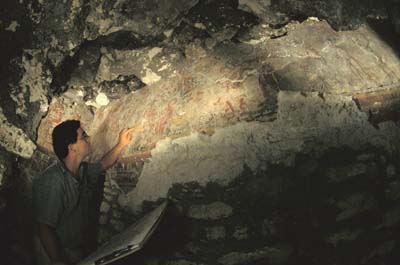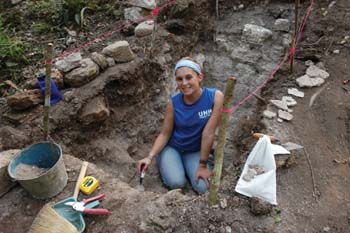 |
 |
| current issue |  |
past issues |  |
send a letter/news |  |
address update |  |
advertise |  |
about us |  |
alumni home |
Short Features
Extramural EducationStudents learn about two cultures 2,000 years apart while excavating a rare Maya site in Guatemala
by Erika L. Mantz
 Assistant professor of archaeology William Saturno and part of a mural in San Bartolo, Guatemala.
Assistant professor of archaeology William Saturno and part of a mural in San Bartolo, Guatemala.
|
Archaeologist William Saturno spends half of every year in the jungle of San Bartolo, Guatemala, painstakingly uncovering what has been called the "Sistine Chapel" of the pre-classic Maya world. He spends the other half in a UNH classroom. This spring, for the first time since his discovery of the 2,000-year-old mural three years ago, the assistant professor of anthropology was able to combine the two parts of his profession.
Accompanying Saturno on this year's move to Central America was not only his own family but six undergraduate students, all but one from UNH. For one month, the students lived in the city of Antigua for Spanish immersion language instruction. They spent the next three months in the rain forest, where they slept on hammocks under tents, ate an endless diet of rice and beans and tried to avoid snakes, scorpions and fire ants.
Under the best of conditions, San Bartolo is four hours from the nearest town along old logging paths that are muddy swamps most of the year. Temperatures were sweltering, and the female students were disappointed to learn that it's a cultural taboo to wear shorts. With water at a premium, daily showers were not an option.
But the inconveniences were quickly forgotten as the students took up the archaeological challenges before them. Mondays through Fridays, the students worked in the field, taking on all jobs from digging test pits to mapping sites. On Saturdays they cleaned and documented ceramics in the lab. Sundays were free for climbing the pyramids and playing games on the nearby helipad. It was also the day the weekly supply truck arrived, bringing essential items the students had paid extra for—Doritos, soda, oranges and Gummi Bears.
 Megan Edwards '05 digs in a test pit in a Maya site in San Bartolo.
Megan Edwards '05 digs in a test pit in a Maya site in San Bartolo.
|
"Those four months were like a badge of honor," says Andy Cacarillo '04. "You've had an experience you know few ever will, and that's an incredible feeling. Having to do without made me think about what is important and what I really need to be happy."
Megan Edwards '05 admits that she was apprehensive about traveling to Central America, but the chance to live in another culture, speak another language and observe history up close won out. "I took out an extra loan because I usually work two jobs every semester. The experience was worth every extra dollar I had to borrow," she says. For Rebecca Lang '05, the project allowed her to explore different aspects of the archaeological process. Lang will spend this fall working on her senior thesis, analyzing the sky band, a line of celestial symbols with a red and yellow band of color underneath that runs the length of the mural.
Scholars say the mural is one of the most important recent discoveries in Maya archaeology. "This is an extraordinary find," Stephen Houston, a professor at Brown University and an expert on Maya archaeology and writing told National Geographic. "The parts of the mural that are visible show a complex iconography and rich palette that we barely suspected for that period."
The mural Saturno discovered while seeking refuge from the hot sun sits on a 12-acre site that includes a large complex built around an 80-foot-tall pyramid. The mural documents the creation mythology of the ancient Maya.
The best known of the classical civilizations of Mesoamerica, the Maya originated in the YucatÓn around 2600 B.C. and rose to prominence around A.D. 250 in present-day southern Mexico, Guatemala, northern Belize and western Honduras. They developed astronomy, calendar systems and hieroglyphic writing and were noted for elaborate and highly decorated ceremonial architecture, including temple-pyramids, palaces and observatories, all built without metal tools. According to Saturno, San Bartolo became active starting about 400 B.C., was abandoned in A.D. 100 and then reoccupied in A.D. 700.
Page: 1 2 Next >Easy to print version
blog comments powered by Disqus

